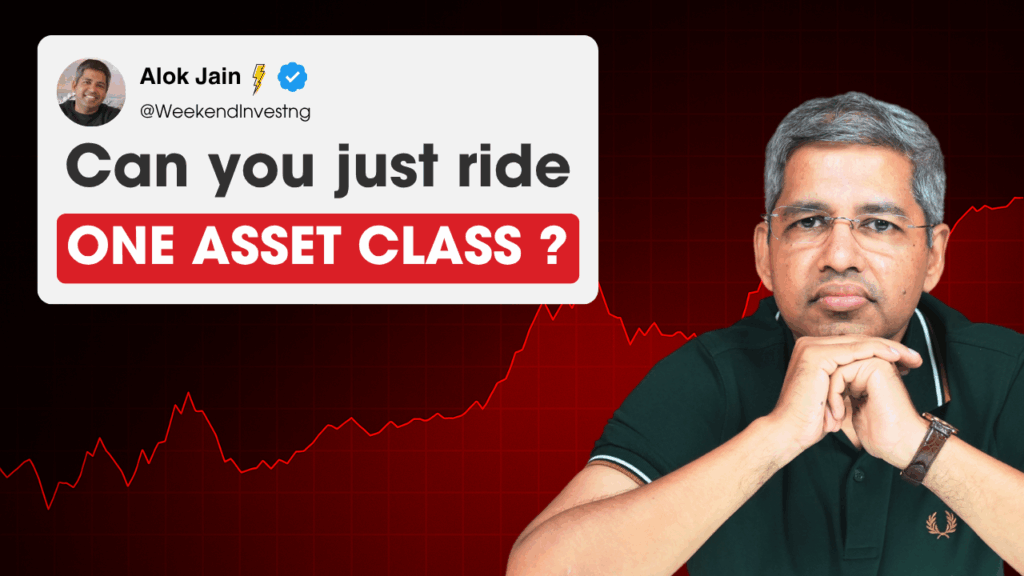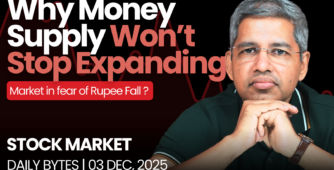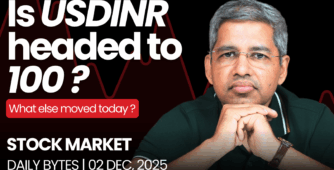Where is the market headed?
A decent start to the month. The reason for this is that the morning news was quite alarming — reports emerged of Ukraine restarting the conflict with Russia by attacking and destroying some Russian assets. This caused fear across various markets earlier in the day.
The Nifty opened nearly 100 points lower, fell to almost 200 points down, but ended the day with only a mild decline—showing underlying strength in the broader market.
Gold has risen, driven by the war specter, while Asian markets were mostly down, especially the Hang Seng and its tech index. Meanwhile, Japan announced it will not negotiate on tariffs, indicating a weakening US position. The dollar index looks poised to fall sharply on the charts, which should benefit emerging markets and precious metals.
Locally, things look quite good. Two-wheeler companies like TVS, Bajaj, and Hero have posted double-digit growth, while Maruti was sluggish, and Mahindra performed well. GST collections for May have been robust. A rate cut is expected this Friday, likely 25 basis points, possibly 50, which could ignite the market. Meanwhile, PSU banks have been gaining momentum over the last couple of sessions, as some speculative activity seems to be underway.
Market Overview
The markets initially dropped over 245 points from the previous close of 24,750, falling more than 200 points, but recovered well and closed within the congestion zone, down just 0.14%.
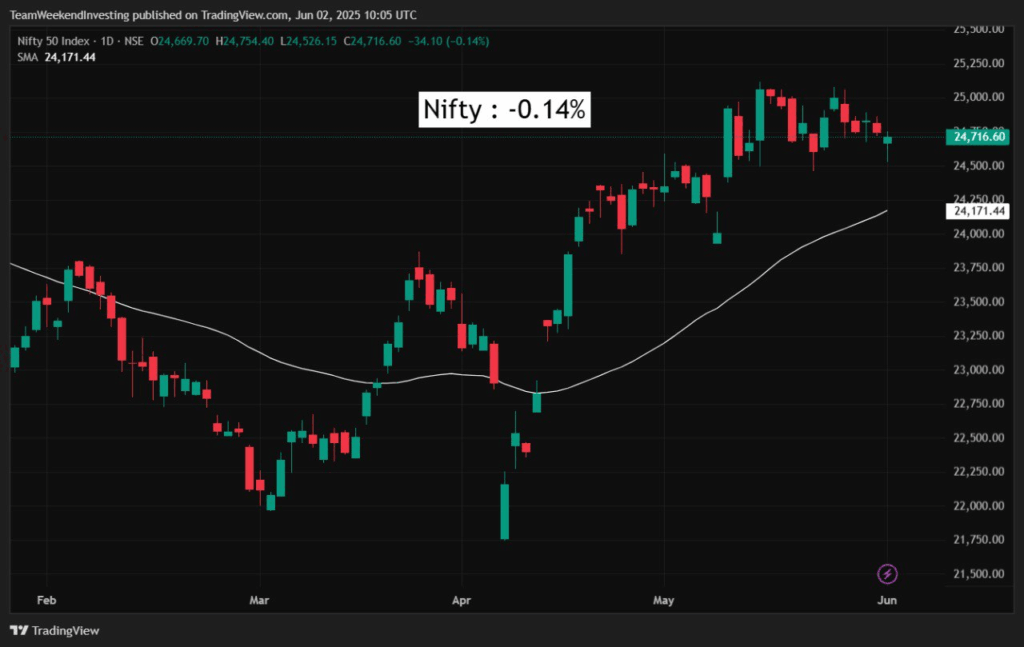
Nifty Next 50
Nifty Junior is up by 0.42%
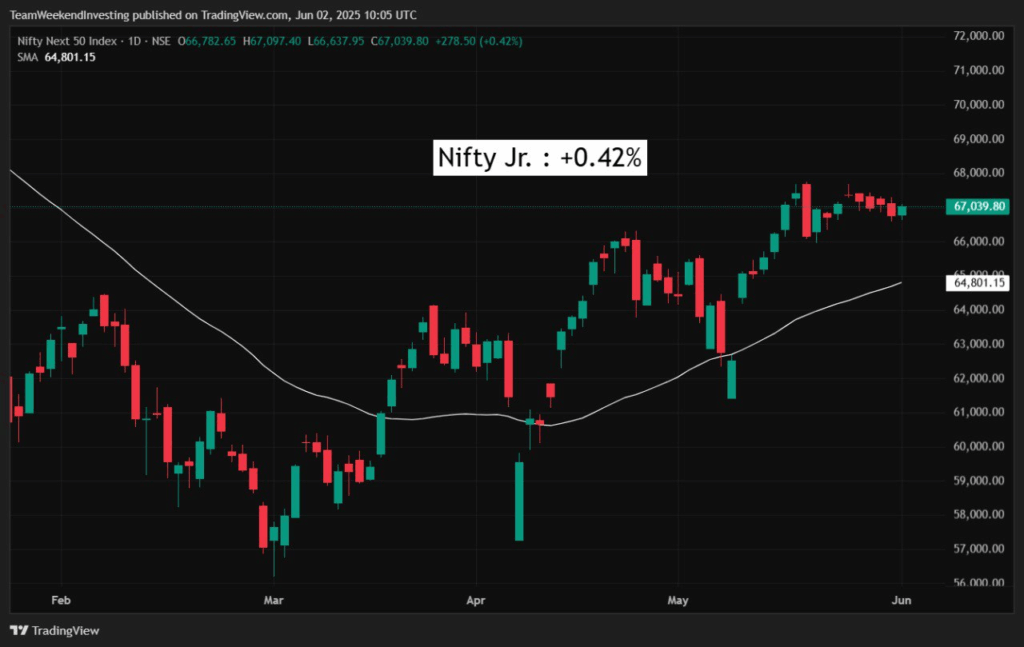
Nifty Mid and Small Cap
Mid caps are up 0.55%, performing very well, while small caps have gained 0.72%, actually leading all the indices today.
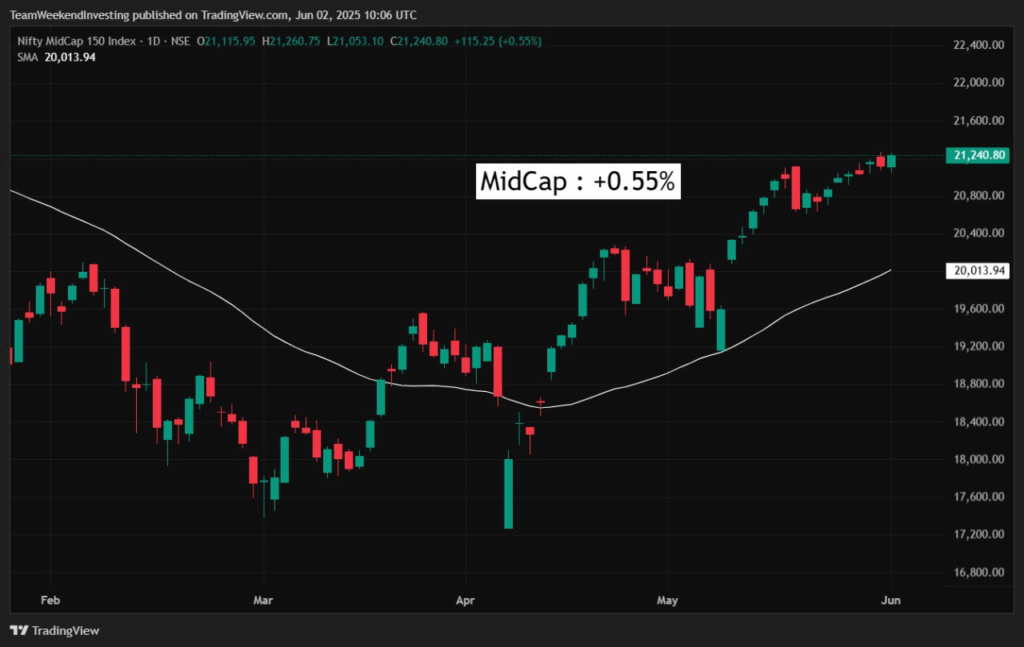
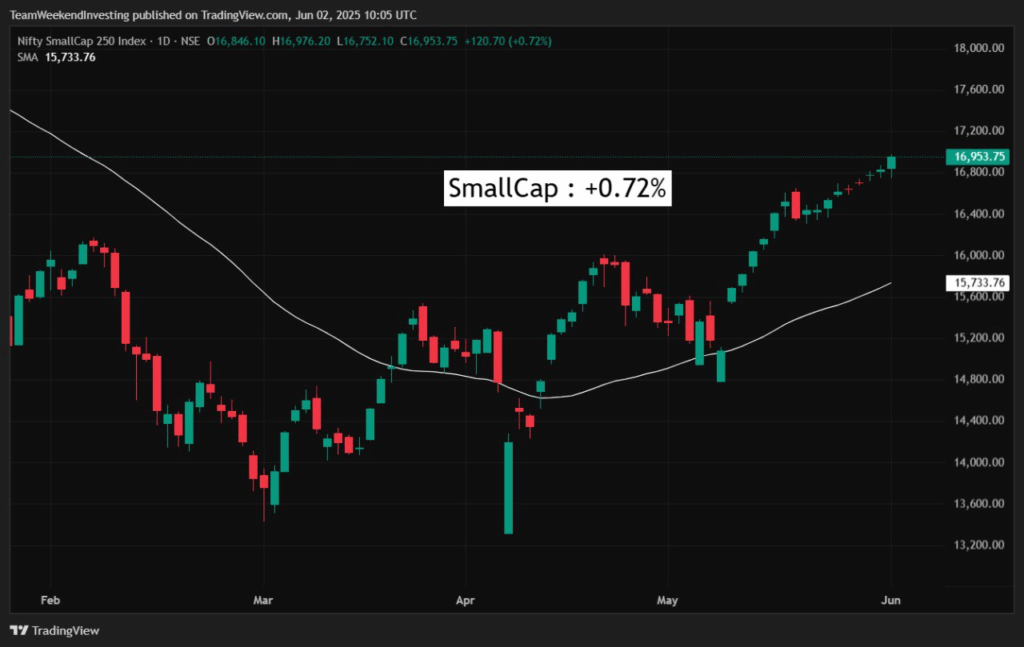
Bank Nifty
Nifty Bank closed up 0.28%, reaching its highest point since entering the current range. The index has the potential to take off strongly, similar to previous movements. A surprise on Friday could trigger a significant rally.
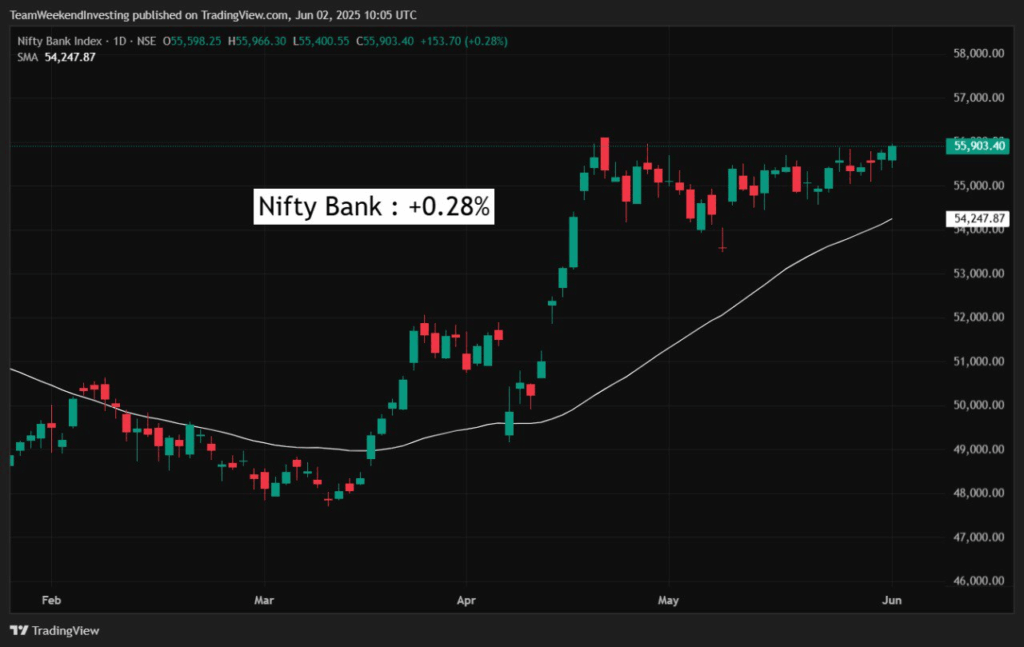
GOLD
Gold is currently at ₹9,735 per gram, once again within striking distance of the all-time high close, which was just below ₹10,000 per gram.
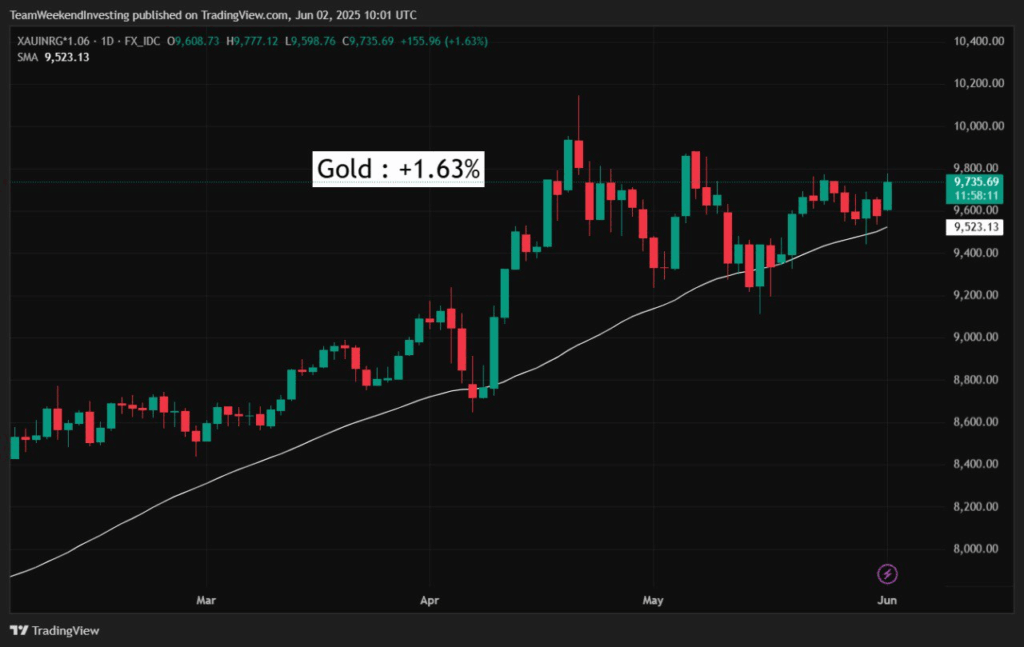
Advance Decline Ratio
Advance-decline ratio remained nearly flat at 282 to 217

Heat Maps
Nifty did not see many gainers today. Adani Ports and Mahindra & Mahindra registered some gains, along with Power Grid, Hindustan Unilever, and a few other sporadic names like Coal India and Shriram Finance. However, there were notable losses in Bajaj Finance, Kotak Bank, and HDFC Bank. Reliance declined moderately—between 0.5% and 1%. Tech Mahindra fell 1.5%, Tata Steel by 1.2%, and Tata Motors by 1.1%.
In the Nifty Next 50 space, more green was visible. DLF, Lodha, Bank of Baroda, PNB, and Canara Bank—all three PSU banks—moved up. Other gainers included JSW Energy, Godrej Consumer Products, United Spirits, Adani Power, Britannia, and Indian Hotels.
On the losing side, TVS Motor saw a decline, likely due to earnings-related news. Other laggards included Shree Cement, Jindal Steel, Vedanta, CG Power, Chola Finance, and Divi’s Laboratories.
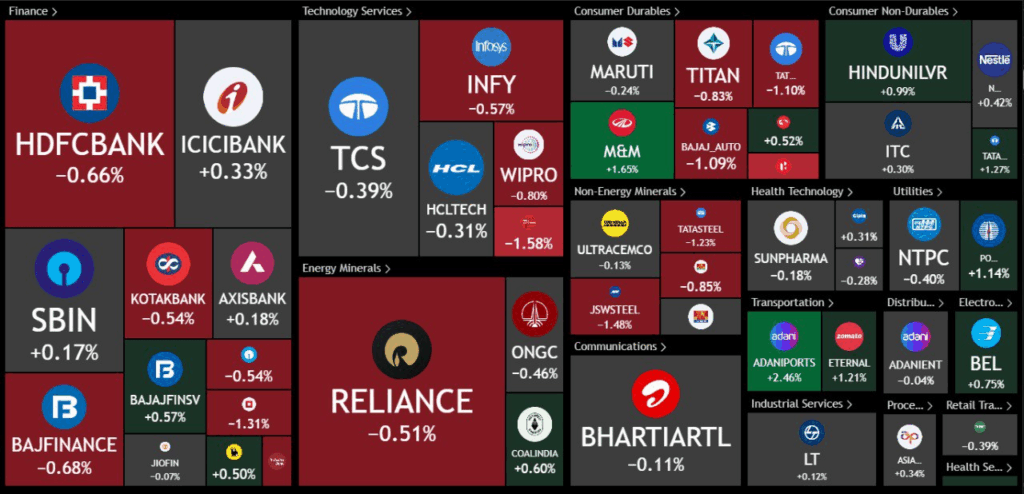
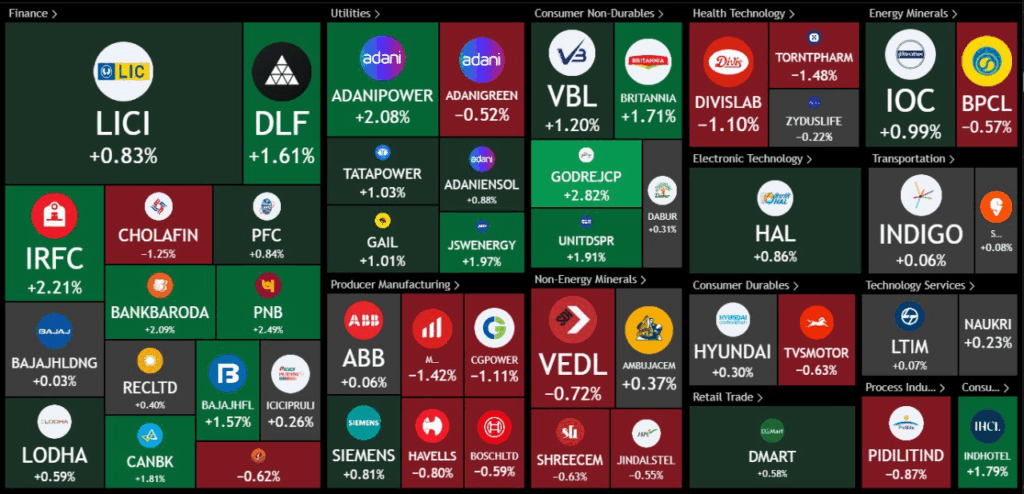
Sectoral Overview
Sectoral trends for the day showed three major peaks. Real estate rose by 2.3%, despite reports indicating a slowdown in Mumbai, with inventory buildup—particularly in the luxury segment. PSU banks performed strongly for the second consecutive session, gaining 2.2%. For the week, PSU banks are up 6.1%, with most of the gains coming on Friday and today. Capital market stocks also rose by 2.2%, with names like BSE and CDSL performing well. Over the past five sessions, the capital market sector has gained 5.5%.
On the downside, metals and IT saw some losses, while FMCG and Indian consumption registered minor gains. The tourism segment also posted a modest gain of 1.1%.

Sector of the Day
Nifty Realty Index
In the real estate space, Brigade made a significant move, gaining 7.5%, while Prestige rose by 4.5%. The second-tier real estate counters are showing strong performance. The real estate index has now crossed its February high, indicating it is outperforming many other sectoral indices.
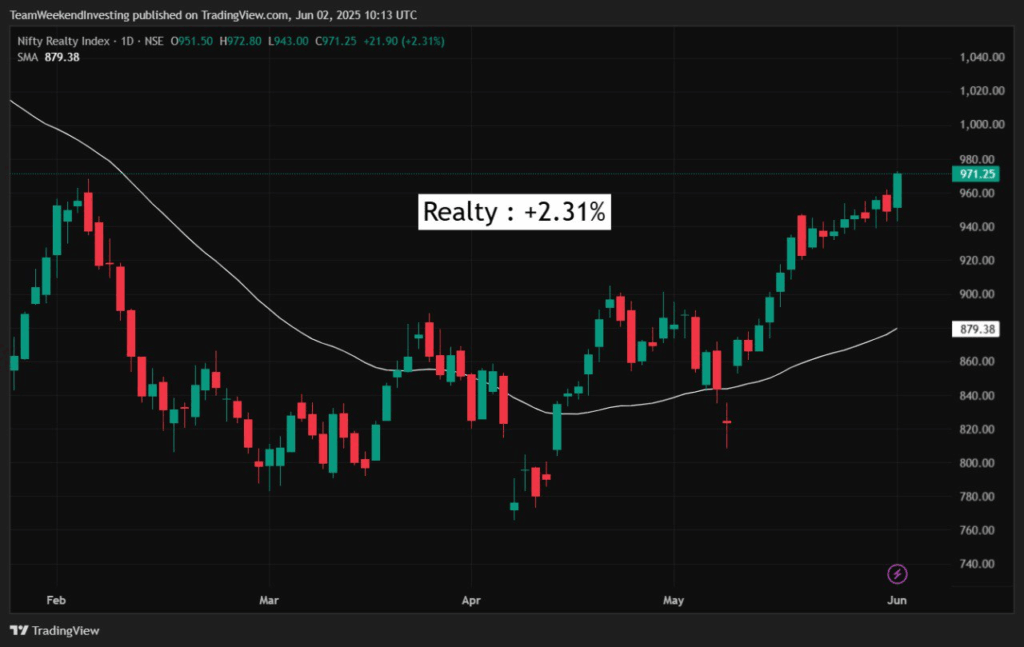

Story of the Day: Can You Rely on Just One Asset Class?
Can a single asset class carry your entire investment journey? At the start of their financial journeys, many investors tend to rely heavily on one asset class—most often equities. It’s a natural choice, especially for younger individuals looking to maximise returns and willing to take on higher risk. But as time passes and the investment corpus grows, a shift usually happens. Risk appetite reduces with age, and diversification begins to matter more than ever.
A 30-year-old might be ready to take bold bets, aiming for outsized returns. On the other hand, a 50 or 60-year-old typically prefers capital preservation and stability, valuing consistency over aggressive growth. This shift in mindset is a common theme seen across investors with different life stages. Young investors often chase high returns and are comfortable with the ups and downs. Older investors, having accumulated wealth, focus more on beating inflation and maintaining capital.
While equity enthusiasts might argue there’s no need to look beyond equities, that approach can lead to tunnel vision. A major assumption here is that the past will repeat itself. For instance, someone in their 30s looking at the last 30 years of Indian market data might expect similar returns over the next 30. But history doesn’t guarantee the future. Markets can face unprecedented shocks. Current conditions—like a booming economy, stable government, and strong currency—may not remain forever. As the stakes grow, so should caution. Asset preservation becomes as important as growth.
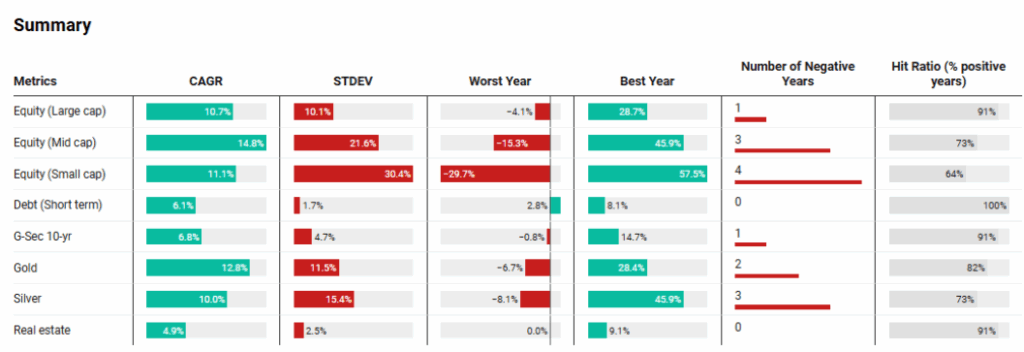
An ET Wealth study highlights this further by analysing multiple asset classes from 2015 to 2025. These include large-cap, mid-cap, and small-cap equities, silver, gold, G-Secs, short-term debt, and real estate. The year-by-year performance tells a clear story—no single asset class dominates consistently.
In 2015, debt and G-Secs outperformed equities and precious metals. But in 2016, silver and G-Secs led the charts while small caps struggled. The trend reversed again in 2017, with small and mid caps surging over 50%. 2018 brought steep declines for equities, while gold held steady.
The pattern continued: 2020 was the year of silver and gold, 2021 belonged to equities, and 2022 again flipped the script with precious metals outperforming stocks. Even 2025 so far has seen gold outperform all major asset classes. This inconsistency clearly shows how each year brings new leaders and laggards.
When the entire decade is considered, the 10-year CAGR tells its own story. Mid caps delivered 14.8%, gold came in next with 12.8%, small caps at 11.1%, large caps at 10.7%, and silver at 10%. Meanwhile, G-Secs delivered 6.8% and short-term debt matched inflation at 6.1%. Real estate, based on the index used, returned just 4.9%. However, real estate’s actual performance could be better in select micro-markets.
Risk and volatility also varied widely. Large caps showed the best stability with only one negative year and a standard deviation of 10.1. Mid and small caps had higher returns but came with much greater volatility—standard deviations of 21.6 and 30.4, and more frequent negative years. Gold stood out for its strong returns with lower volatility and fewer negative years compared to equities. Silver, while decent, was more volatile and had more down years.
The key takeaway is that different asset classes react differently to economic shifts. Gold tends to shine during geopolitical tensions or financial uncertainty. Equities perform well in strong economic cycles. Debt offers safety during downturns. This lack of correlation helps smooth out portfolio returns. For those who dislike seeing their portfolios swing wildly—say from ₹1 crore to ₹3 crore, down to ₹1 crore again, then up to ₹5 crore—a diversified strategy offers a more stable journey, even if the growth isn’t as explosive.
Ultimately, it comes down to individual preference. Some investors are comfortable with volatility and aim for maximum returns. Others value steady growth and peace of mind. But what’s clear is that no single asset class can win every year. Diversification is key. Spreading investments across uncorrelated assets can cushion against shocks and offer a balanced growth path over time.
So, which asset class do you think will lead the race in 2025? Share your views in the comments! And if you found this analysis helpful, don’t forget to SHARE it with your friends!
WeekendInvesting launches – The Momentum Podcast
Join us on The MOMENTUM PODCAST as we sit down with Venkatesh, a dynamic product manager and MBA graduate from Hyderabad. Discover his incredible journey from starting investing during the 2020 COVID crash to achieving a remarkable 5X salary jump!
In this insightful conversation, Venkatesh shares:
✅ His early investing blunders and crucial lessons learned.
✅ How he built a disciplined investing routine with Nifty index funds and direct stocks like Tata Elxsi.
✅ The surprising benefits of his IT domain knowledge in stock picking.
✅ His long-term vision for financial independence and strategic wealth building.
✅ Why he prioritizes investments and EMIs (including his home loan!) before anything else.
If you’re a young professional looking to kickstart your investment journey or seeking inspiration for disciplined wealth creation, this episode is a must-watch!

